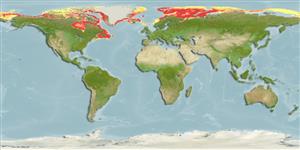>
Perciformes/Zoarcoidei (Eelpouts and pricklebacks) >
Zoarcidae (Eelpouts) > Lycodinae
Etymology: Lycodes: Greek, lykos = wolf + Greek, suffix, oides = similar to (Ref. 45335).
Eponymy: Rear-Admiral Sir James Clark Ross (1800–1862) discovered the Ross Sea and the Ross Ice Shelf and an island (1841) which Scott, on his first expedition, named Ross Island in his honour. [...] (Ref. 128868), visit book page.
Environment: milieu / climate zone / depth range / distribution range
Ökologie
seewasser demersal; tiefenbereich 42 - 365 m (Ref. 11976). Polar
North Atlantic: just north of Iceland, northern Norway (Porsanger Fjord) and Barents Sea (but not in southern parts). Arctic Ocean: Kara Sea and Beaufort Sea.
Size / Gewicht / Alter
Maturity: Lm ? range ? - ? cm
Max length : 31.0 cm TL Männchen/unbestimmt; (Ref. 4695); max. veröff. Gewicht: 63.60 g (Ref. 11976)
Kurzbeschreibung
Bestimmungsschlüssel | Morphologie | Morphometrie
Wirbelzahl: 98 - 99. Pelvic fins small (Ref. 4695). Dark, with 5-8 short, light cross-bands on back and dorsal fins; light band (or spots) at nape; transverse light bands on body, never becoming a network in older fishes (Ref. 4695).
Found on muddy bottoms (Ref. 4695). Benthic (Ref. 58426). Smaller individuals prey on smaller species like amphipods, isopods and small bivalves while larger ones prey on shrimps, euphausiids and fish (Ref. 13532).
Life cycle and mating behavior
Geschlechtsreife | Fortpflanzung | Ablaichen | Eier | Fecundity | Larven
Andriashev, A.P., 1986. Zoarcidae. p. 1130-1150. In P.J.P. Whitehead, M.-L. Bauchot, J.-C. Hureau, J. Nielsen and E. Tortonese (eds.) Fishes of the North-eastern Atlantic and the Mediterranean. volume 3. UNESCO, Paris. (Ref. 4695)
IUCN Rote Liste Status (Ref. 130435: Version 2024-1)
Bedrohung für Menschen
Harmless
Nutzung durch Menschen
Tools
Zusatzinformationen
Download XML
Internet Quellen
Estimates based on models
Preferred temperature (Ref.
123201): -1.6 - 2.6, mean -0.5 °C (based on 2194 cells).
Phylogenetic diversity index (Ref.
82804): PD
50 = 0.5000 [Uniqueness, from 0.5 = low to 2.0 = high].
Bayesian length-weight: a=0.00269 (0.00141 - 0.00516), b=3.22 (3.06 - 3.38), in cm total length, based on LWR estimates for this Genus-body shape (Ref.
93245).
Trophic level (Ref.
69278): 3.5 ±0.55 se; based on food items.
Widerstandsfähigkeit (Ref.
120179): niedrig, Verdopplung der Population dauert 4,5 - 14 Jahre. (Preliminary K or Fecundity.).
Fishing Vulnerability (Ref.
59153): Low vulnerability (21 of 100).
